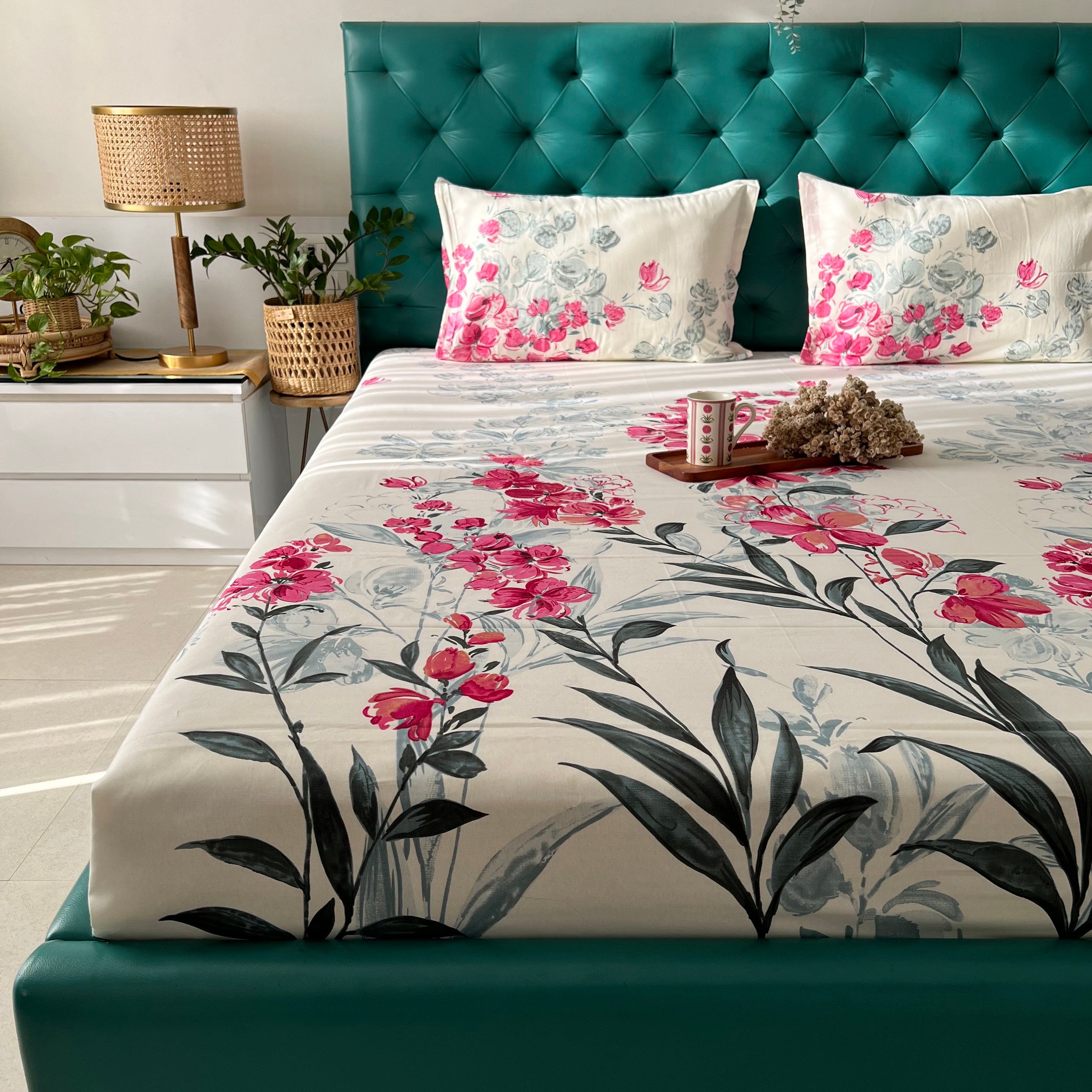The Art of Crafting Bedsheets: Understanding the Full Manufacturing Process

Introduction:
Bedsheets are an essential part of our everyday lives, offering comfort and style to our bedrooms. Have you ever wondered how these cozy pieces of fabric are made? In this blog, we will take you through the intricate process of crafting bedsheets from start to finish. From fabric weaving to dyeing techniques, thread count, and finishing processes, each step contributes to the quality and appearance of the final product. Let's dive into the fascinating world of bedsheet manufacturing, exploring the influence of Indian bedsheets and prints in this creative journey.
I. Fabric Weaving: Laying the Foundation

Fabric weaving is the fundamental process of creating bedsheets. It involves intertwining vertical (warp) and horizontal (weft) yarns to form the desired textile structure. Three popular fabric weaves used in bedsheets are:
- Percale: Known for its crisp and cool feel, percale is woven in a one-under, one-over pattern, resulting in a lightweight and breathable fabric ideal for warm climates.
- Sateen: Sateen is woven in a four-over, one-under pattern, giving it a lustrous and smooth surface. It has a soft and luxurious feel, making it a popular choice for those seeking a touch of elegance.
- Jersey: Jersey is a stretchy and comfortable knit fabric known for its softness. It is perfect for casual and relaxed bedding with its natural elasticity.
II. Dyeing Techniques: Infusing Colors and Patterns
Once the fabric is woven, it is time to add color and patterns through dyeing techniques. In recent times, consumers have shown a growing interest in eco-friendly and sustainable dyeing methods. Popular dyeing techniques include:
- Eco-Friendly Dyeing: With an increasing focus on environmental consciousness, eco-friendly dyeing methods use natural or low-impact dyes that are less harmful to the environment.
- Digital Printing: Digital printing allows intricate and vibrant designs to be directly printed onto the fabric. This technique enables manufacturers to create intricate patterns and detailed imagery on bedsheets.
- Natural Dyes: Natural dyes are derived from plant sources, offering a wide range of earthy and organic colors. Bedsheets dyed with natural pigments have a unique charm and are favored by those seeking a connection to nature.
III. Thread Count: The Quality Indicator

Thread count is a prominent keyword associated with bedsheets and is often used as a quality indicator. It refers to the number of threads woven into one square inch of fabric. A higher thread count does not always equate to better quality. Instead, the ideal thread count depends on the type of fabric and weave used. For instance, percale bedsheets typically have a thread count of 200-400, while sateen bedsheets may range from 300-600.
Read more: Choosing the Perfect Bedsheet Material: A Guide to Comfort and Quality
IV. Finishing Processes: Enhancing Comfort and Aesthetics
After dyeing, bedsheets undergo various finishing processes that enhance their texture and appearance. Some popular finishing techniques include:
- Stone-Washing: Stone-washing is a process that gives bedsheets a soft and worn-in feel. The fabric is tumbled with stones, which help to break down the fibers and create a relaxed and lived-in texture.
- Sateen Finish: Sateen bedsheets often undergo a finishing process that enhances their smooth and lustrous appearance. The fabric is treated to achieve a subtle sheen, adding a touch of luxury to the bedding.
- Wrinkle-Resistance: Bedsheets can be treated with wrinkle-resistant finishes to reduce creasing and make them easier to maintain.
V. The Influence of Indian Bedsheets and Prints
Indian bedsheets have a timeless appeal, known for their intricate designs and vibrant colors. Traditional Indian prints, such as paisleys, mandalas, and florals, are widely adored for their rich cultural heritage. Indian-inspired bedding often features a harmonious blend of contemporary designs with ethnic motifs, creating a unique and captivating look for the bedroom.
Conclusion:
The art of crafting bedsheets involves a series of intricate steps, from fabric weaving and dyeing techniques to thread count and finishing processes. Each aspect contributes to the quality, comfort, and aesthetics of the final product. Indian bedsheets and prints add a touch of cultural richness and artistic flair to the world of bedding, offering a unique and captivating experience for any bedroom. As you explore the world of bedsheets, consider the fabric weaves, dyeing methods, and finishing techniques that suit your preferences. With a wide range of choices available, you can create a stunning and comfortable sleep sanctuary that reflects your personal style and embraces the charm of Indian-inspired prints. Happy bedsheet shopping!
FAQs:
Q1: Are Indian bedsheets suitable for all seasons?
A1: Yes, Indian bedsheets come in various fabric weaves, making them suitable for different seasons. Light and breathable percale bedsheets are ideal for summers, while jersey bedsheets provide warmth and coziness during colder months.
Q2: What is the average thread count for comfortable bedsheets?
A2: For most people, bedsheets with a thread count ranging from 200 to 400 provide a comfortable and soft sleeping experience.
Q3: Can I find Indian-inspired bedding in eco-friendly dyeing options?
A3: Yes, many manufacturers offer Indian-inspired bedding with eco-friendly dyeing methods, allowing you to embrace traditional prints while being environmentally conscious.
